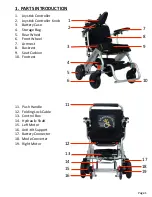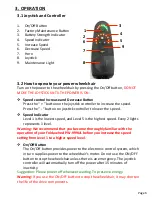
The sources of radiated EMI can be broadly classified into three types :
1.
Hand-‐held portable transceivers ( transmiXer-‐receivers with the antenna
mounted directly on the transmicng unit. Examples include: ci2zen
band (CB) radios, “walkie talkie”, security, fire, and police transceivers,
cellular telephones and other personal communica2on devices.
AXen2on : Some cellular telephones transmit signals while they are ON,
even when not being used.
2.
Medium-‐range mobile transceivers, such as those used in police cars, fire
trucks, ambulances and taxis. These usually have the antenna mounted
on the outside of the power wheelchair.
3.
Long-‐range transmiXers and transceivers, such as commercial broadcast
transmiXers (radio and TV broadcast antenna towers) and amateur
(HAM) radios.
AXen2on : Other types of hand-‐held devices, such as cordless phones,
laptop computers, AM/FM radios, TV sets, CD players, casseXe and small
appliances such as electric shavers and hair dryers are not likely to cause
EMI problems to your power wheelchair.
v
Power Wheelchair ElectromagneVc Interference (EMI)
Because EM energy rapidly becomes more intense as one moves closer to
the transmicng antenna (source), the EM fields from hand-‐held radio wave
sources (transceivers) are of special concern. It is possible to uninten2onally
bring high levels of EM energy very close to the power control system of the
power wheelchair while using these devices. This can affect the power
wheelchair movement and braking. Therefore, the warnings listed below
are recommended to prevent possible interference with the control system
of the power wheelchair.
v
Warnings
Electromagne2c interference (EMI) from sources such as radio and TV
sta2ons, amateur radio (HAM) transmiXers, two-‐way radio, and cellular
phones can affect power wheelchairs and motorized power wheelchairs.
Following the warnings listed below should reduce the chance of
unintended brake release or power wheelchair movement which could
result in serious injury.
1.
Do not operate hand-‐held transceivers-‐receivers, such as ci2zen band
(CB) radios, or turn ON personal communica2on devices such as
cellular phones, while the power wheelchair is turned ON.
Page 12



































